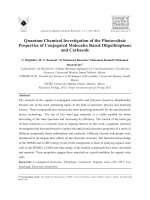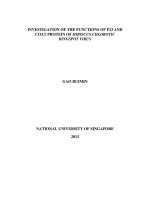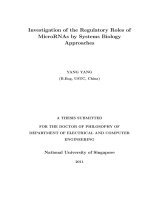quantum chemical investigation of the photovoltaic
Bạn đang xem bản rút gọn của tài liệu. Xem và tải ngay bản đầy đủ của tài liệu tại đây (2.27 MB, 14 trang )
-Journal of Applied Chemical Research, 7, 4, 71-84 (2013)
Journal of
Applied
Chemical
Research
www.jacr.kiau.ac.ir
Quantum Chemical Investigation of the Photovoltaic
Properties of Conjugated Molecules Based Oligothiophene
and Carbazole
N. Belghiti1, M. N. Bennani
1
, Si Mohamed Bouzzine
2
,Mohamed Hamidi
2
,Mohamed
Bouachrine
3*
1
Laboratoire de Recherche «Chimie-Biologie appliquées à l’environnement», Faculté des
Sciences, Université Moulay Ismail Meknès, Maroc.
2
URMM/UCTA, Faculté des Sciences et Techniques d’Errachidia, Université Moulay Ismaïl,
Maroc.
3
ESTM, Université Moulay Ismail, Meknes, Maroc.
Received 10 Aug. 2013; Final version received 18 Sep.2013
Abstract
The research in the organic π-conjugated molecules and polymers based on thiophenehas
become one of the most interesting topics in the eld of chemistry physics and materials
science. These compounds have become the most promising materials for the optoelectronic
device technology The use of low band gap materials is a viable method for better
harvesting of the solar spectrum and increasing its efciency. The control of the band gap
of these materials is a research issue of ongoing interest. In this work, a quantum chemical
investigation has been performed to explore the optical and electronic properties of a series of
different compounds based onthiophene and carbazole. Different electron side groups were
introduced to investigate their effects on the electronic structure. The theoretical knowledge
of the HOMO and LUMO energy levels of the components is basic in studying organic solar
cells so the HOMO, LUMO and Gap energy of the studied compounds have been calculated
and reported. These properties suggest these materials as a good candidate for organic solar
cells.
Keywords: π-conjugated molecules, Thiophene, Carbazole, Organic solar cells, DFT, Low
band-gap, Electronic properties.
*Corresponding author: Dr. Mohamed Bouachrine, ESTM, Université Moulay Ismail, Meknes, Maroc. Email: bouachrine@
gmail.com.
M. Bouachrine et al., J. Appl. Chem. Res., 7, 4, 71-84 (2013)
72
Introduction
During the past decade, thiophene-
based electronic materials have been
extensively investigated. The ease in the
chemical modication of their structures
can potentially allow us to ne-tune their
optical and electronic properties [1]. These
properties strongly depend on the degree
of electronic delocalisation present in these
materials, effective conjugation length, and
the introduction of substitutes. Whereas
obtained polymers as highly amorphous,
oligomers are not amorphous and can be
synthesized as well dened compounds.
Recently, many researchers have become
interested in synthesizing short-chain OLED
compounds based on conjugated oligomers
[2]. These materials offer advantages over
polymeric systems in terms of easy synthesis
and purication, and generally exhibit high
charge carrier mobility. Therefore designing
and synthesizing molecules with interesting
properties play a crucial role in technology.
At the same time it is important to understand
the nature of the relationship between the
molecular structure and the electronic
properties to provide guidelines for the
development of new materials.
Theoretical analysis of the electronic structure
of conjugated systems can establish the
relationships between molecular structure and
electronic properties [3]. Theoretical studies
on the electronic structures of π-conjugated
compounds have given great contributions to
the rationalization of the properties of known
materials and to the properties prediction those
of yet unknown ones. In this context, quantum-
chemical methods have been increasingly
applied to predict the band gap of conjugated
systems [4]. We note that theoretical
knowledge of the HOMO and LUMO energy
levels of the components is crucial in studying
organic solar cells [5]. So, we can save time
and money by choosing the adequate organic
materials to optimize photovoltaicdevice’s
properties. The HOMO and LUMO energy
levels of the donor and of the acceptor
components for photovoltaic devices are
very important factors to determine whether
the effective charge transfer will happen
between donor and acceptor. The offset of
band edges of the HOMO and LUMO levels
will prove responsible for the improvement of
all photovoltaic properties of the organic solar
cells.
Recently,Marrocchiet al. [6]have described
the synthesis of a series of compoundsbased
on thiophene and carbazole(Figure 1).
Oligothiophene and carbazolederivatives
may exhibit large charge carrier mobility
and excellent stability. To the best of your
knowledge a systematic theoretical study
of such compounds has not been reported.
The theoretical knowledge of the HOMO
and LUMO energy levels of the components
is a basis in studying organic solar cells As
M. Bouachrine et al., J. Appl. Chem. Res., 7, 4, 71-84 (2013)
73
the HOMO, LUMO and Gap energy of the
studied compounds have been calculated and
reported. Theirproperties suggest they are
good candidates for organic solar cells.
PCDT :
PCDTB :
PCDTBT :
PCTTT :
PCTPY :
PCTPYPP :
N
S
S
d
1
(O)
d
2
(O)
d
3
(O) d
4
(O)
N
S
S
d
1
d
2
d
3
d
4
d
5
N
d
1
d
2
d
5
d
3
d
4
S
S
N
N
S
N
S
S
S
d
1
d
2
d
3
d
4
d
5
N
S
S
S
NN
d
1
d
2
d
3
d
4
d
5
Figure 1.The sketch map of studying structures (PCDT, PCDTB, PCDTBT, PCTTT, PCTPY, PCTPYPP).
N
S
d
1
d
2
d
3
d
4
d
5
S
S
N
N
M. Bouachrine et al., J. Appl. Chem. Res., 7, 4, 71-84 (2013)
74
Theoretical methodology
DFT method of three-parameter compound of
Becke (B3LYP) [7] was used in all the study
of the neutral and polaroniccompounds. The
6-31G(d) basis set was used for all calculations
[8]. To obtain the charged structures, we start
from the optimized structures of the neutral
form. The calculations were carried out using
the GAUSSIAN 03 program [9]. The geometry
structures of neutral and doped molecules were
optimized under no constraint. We have also
examined HOMO and LUMO levels; the energy
gap is evaluated as the difference between the
HOMO and LUMO energies. The ground
state energies and oscillator strengths were
investigated using the ZINDO/s, calculations
on the fully optimized geometries. In fact, these
calculation methods have been successfully
applied to other conjugated polymers [10].
Results and discussion
Molecular design and geometry structures
The optimized structures of all studied compounds
are illustrated in gure 2. It’s revealed that the
pi-electron delocalization between the different
aromatic units is clear. For saying about the effect
of increasing additional π-bridge conjugated
thiophene, PCDT, PCDTB, PCDTBT, PCTTT,
PCTPY, PCTPYPP are studied. Molecules
PCTTT and PCDTB are designed in order
to examine the effect of replacement of the
thiophene ring by phenyleneandnally in order
to examine the effect of the number of additional
thiophen, molecule PCDT and PCTTTare
designed. All the molecular geometries have
been calculated with the hybrid B3LYP function
combined with 6-31G (d) basis sets using
Gaussian 03 program. It was found in other
works [11] that the DFT-optimized geometries
were in excellent agreement with the data
obtained from X-ray analyses. The results of the
optimized structures for all studied compounds
show that they have similar conformation (quasi
planar conformation) (see Figure 2). We found
that the consecutive units have similar dihedral
angles and inter-ring distances means that the
incorporation of several groups does not change
these parameters.
PCDT :
M. Bouachrine et al., J. Appl. Chem. Res., 7, 4, 71-84 (2013)
75
PCDTB :
PCDTBT :
PCTTT :
PCTPY :
M. Bouachrine et al., J. Appl. Chem. Res., 7, 4, 71-84 (2013)
76
PCTPYPP :
Figure 2.Optimized structure of the studied compound obtained by B3LYP/6-31G level.
Table 1. Geometrical parameters of study compounds C
1
to C
6
obtained by B3LYP/6-31G(d) in their neutral (N)
and doped (D) states.
PCDT
PCDTB
d
1
(Å)
1.485
Ԧ
1
(°)
38.39
d
1
(Å)
1.48559
Ԧ
1
(°)
38.19
d
2
(Å)
1.465
Ԧ
2
(°)
27.69
d
2
(Å)
1.46601
Ԧ
2
(°)
26.86
d
3
(Å)
1.445
Ԧ
3
(°)
17.58
d
3
(Å)
1.46328
Ԧ
3
(°)
23.95
d
4
(Å)
1.466
Ԧ
4
(°)
26.92
d
4
(Å)
1.46363
Ԧ
4
(°)
24.25
d
5
(Å)
1.46679
Ԧ
5
(°)
25.41
PCDTBT
PCTTT
d
1
(Å)
1.485
Ԧ
1
(°)
38.19
d
1
(Å)
1.485
Ԧ
1
(°)
38.48
d
2
(Å)
1.465
Ԧ
2
(°)
27.14
d
2
(Å)
1.465
Ԧ
2
(°)
27.67
d
3
(Å)
1.454
Ԧ
3
(°)
5.791
d
3
(Å)
1.444
Ԧ
3
(°)
15.71
d
4
(Å)
1.455
Ԧ
4
(°)
4.916
d
4
(Å)
1.444
Ԧ
4
(°)
16.34
d
5
(Å)
1.466
Ԧ
5
(°)
25.37
d
5
(Å)
1.465
Ԧ
5
(°)
25.60
PCTPY
PCTPYPP
d
1
(Å)
1.485
Ԧ
1
(°)
38.79
d
1
(Å)
1.489
Ԧ
1
(°)
59.01
d
2
(Å)
1.46450
Ԧ
2
(°)
26.34
d
2
(Å)
1.473
Ԧ
2
(°)
41.41
d
3
(Å)
1.43450
Ԧ
3
(°)
1.563
d
3
(Å)
1.436
Ԧ
3
(°)
5.564
d
4
(Å)
1.43684
Ԧ
4
(°)
1.834
d
4
(Å)
1.440
Ԧ
4
(°)
6.494
d
5
(Å)
1.46437
Ԧ
5
(°)
24.71
d
5
(Å)
1.480
Ԧ
5
(°)
74.38
M. Bouachrine et al., J. Appl. Chem. Res., 7, 4, 71-84 (2013)
77
On the other hand, it is interesting to study how
the p-doped π-conjugated molecule becomes the
ultimate responsible of chargetransport. As said
before, to obtain oxidized optimized structure,
we started from the optimized structure of the
neutral form. We can conclude that during the
doping process and for all studied compounds the
simple bonds become shorter, while the double
ones become longer (Table 2). The inter-rings
bonds are longer than normal double bonds. A
quinoid-like distortion emerges as a result of the
oxidation. These results are consistent with the
ab-initio HF and DFT calculations performed
byJ. Casado et al. [12] And S.M Bouzzine et
al [13] for substitutingoligothiophenes.The
optimized geometry of the cationic compound
indicates the formation of the positive) polaron
defect localized in the middle of the molecule
and extending over the adjacent repeat units.
The charged species are characterized by
a reversal of the single double C-C bond
pattern; the geometry process thus induces the
appearance of a strong quinoid character within
the molecule.
Table 2. Comparison between di and Ԧi forms PCTPYPP neutral and doped.
PCTPYPP neutral
PCTPYPP doped
d
1
(
Å
)
1.489
1.482
d
2
(
Å
)
1.473
1.443
d
3
(
Å
)
1.436
1.403
d4(
Å
)
1.440
1.411
d
5
(
Å
)
1.480
1.456
Ԧ
1
(°)
59.01
37.27
Ԧ
2
(°)
-
41.41
11.77
Ԧ
3
(°)
5.56
1.12
Ԧ
4
(°)
6.49
3.37
Ԧ
5
(°)
74.38
19.95
Electronic and photovoltaic properties
Electronic structures are fundamental to
the interpretation and understanding of the
absorption spectra. The calculated frontier
orbital energies (fours occupied orbital and
fours unoccupied orbital) and energy gaps
between highest occupied molecular orbital
(HOMO) and lowest unoccupied molecular
orbital (LUMO) are listed in Table 3. As shown
in Table 3, one remark that all studied molecules
(PCDT, PCDTB, PCDTBT, PCTTT, PCTPY,
PCTPYPP) exhibit stabilization HOMO levels
in comparison with those of compound PCDT.
The HOMO and LUMO energies ofPCDT to
PCTPYPP change signicantly, (respectively:
-4.96 eV and -1.67eV ; -5.00eV and -1.68eV ;
-4.97eV and -2.60eV ; -4.86eV and -1.86eV ;
-4.71eV and -2.63eV ; -4.64eV and -2.57eV). It
can also be found that, the HOMO and LUMO
energies of the studied compoundares lightly
different. This implies that different structures
play key roleson electronic properties. In
addition, the energies of E
gap
of differing
slightly from 3.32eV to 2.07eV depending
M. Bouachrine et al., J. Appl. Chem. Res., 7, 4, 71-84 (2013)
78
on the different structures. They are studied
in the following order PCDTB>PCDT>PCT
TT>PCDTBT>PCTPY>PCTPYPP. For the
comparison between PCDT (HOMO: -4.96eV,
LUMO: -1.67eV) and PCTTT (HOMO:
-4.86eV, LUMO: -1.86 eV) compounds,
itcanbeseena net stabilization of LUMO
energies and destabilization of the energies of
HOMO.The energygap between HOMO and
LUMO of PCTTT is also lower than that of
PCDT with alower energy gap (3.00eV). This
may be attributed to the presence of an additive
thiophene ring in PCTTT. On the other hand
the comparison between PCTTT and PCDTB
show that the replacement of thiophene
ringbyphenylene causes a increase of band
Gap accompanying with a net stabilization
of HOMO and destabilization LUMO levels.
This is in agreement with what it was found in
experimental results [6].
Table 3.
Values of HOMO (eV), LUMO (eV) and Egap (eV) energies calculated for the studied compound
obtained by B3LYP/6-31G(d).
Compounds E(LUMO) (eV) E(HOMO) (eV) Egap (eV)
PCDT
-
1.67
-
4.96
3.29
PCDTB
-
1.6
8
-
5.00
3.32
PCDTBT
-
2.60
-
4.97
2.36
PCTTT
-
1.86
-
4.86
3.00
PCTPY
-
2.63
-
4.71
2.07
PCTPYPP
-
2.57
-
4.64
2.07
The calculated band gap Egap of the studied
compound increases in the following orde
rPCDTB>PCDT>PCTTT>PCDTBT>PCT
PY> PCTPYPP. Figure 3 shows detailed
data of absolute energy of the frontier orbitals
for studying compounds, ITO, PCBM and
aluminum (Al) is included for comparison
purposes. It is deduced that substitution
pushes up/down the HOMO/LUMO energies
in agreement with their electron acceptor
character. To evaluate the possibilities of
electron transfer from the excited studied
molecules to the conductive band of PCBM,
the HOMO and LUMO levels were compared.
As shown in Table 4, the change of molecular
structure shows a great effect on the HOMO
and on the LUMO levels. The experiment
phenomenon was quite consistent with
previous literature [14], which reported
that the increase of the HOMO levels may
suggest a negative effect on organic solar cell
performance due to the broader gap between
the HOMO level of the organic molecules and
the LUMO level of PCBM (V
oc
). As shown
in gure 3, both HOMO and LUMO levels
of the studied molecules agreed well with the
M. Bouachrine et al., J. Appl. Chem. Res., 7, 4, 71-84 (2013)
79
requirement for an efcient photosentizer. On
the one hand, the HOMO levels of the studied
compoundswere higher than that of PCBM.
Knowingthat in organicsolarcells, the open
circuit voltage isfound to belinearlydependent
on the HOMO level of the donor and
the LUMO level of the acceptor[15].The
difference between the energy of conduction
band (LUMO) of PCBM and the energy of
HOMO of the studied molecules range from
1.42 eV to 1.78 eV ,these valuesare sufcient
for a possible efcient electron injection.
Therefore, all the studied molecules can
be used as sensitizers because the electron
injection process from the excited molecule
to the conduction band of PCBM and the
subsequent regeneration is possible in an
organic sensitized solar cell.
Figure 3.Data of the absolute energy of the frontier orbitals HOMO and LUMO for the studied molecules
and ITO, PCBM and the aluminum (Al).
-6
-5
-4
-3
-2
-1
LUMO
HOMO
PCDTPYPP
PCDTPY
PCDTTT
PCDTBT
PCDTB
PCDT
PCBM
Al
ITO
Energy (eV)
Table4.Energyvalues of E
LUMO
(ev), E
HOMO
(ev) andtheopen circuit voltage V
oc
(ev) [16].
Compounds
E(LUMO) (ev)
E(HOMO) (ev)
Į
i
(ev)
Voc(ev)
PCDT
-
1.67
-
4.96
1.55
1.74
PCDTB
-
1.68
-
5.00
1.53
1.78
PCDTBT
-
2.60
-
4.97
0.62
1.74
PCTTT
-
1.86
-
4.86
1.36
1.63
PCTPY
-
2.63
-
4.71
0.59
1.48
PCTPYPP
-
2.57
-
4.64
0.65
1.42
PCBM
-
3.22
-
5.98
Table 4.
M. Bouachrine et al., J. Appl. Chem. Res., 7, 4, 71-84 (2013)
80
Finally, it is important to examine the HOMO
and the LUMO for these compounds because
the relative ordering of occupied and virtual
orbital provides a reasonable qualitative
indication of excitations properties [17].
In general, as shown in Figure 4 (LUMO,
HOMO), the HOMOs of these oligomers in
the neutral form possess a π-bonding character
within subunit and a π-antibonding character
between the consecutive subunits while the
LUMOs possess a π-antibonding character
within subunit and a π-bonding character
between the subunits whereas it is the opposite
in the case of doped forms.
HOMO LUMO
(PCDT)
(PCDTB)
(PCDTBT)
M. Bouachrine et al., J. Appl. Chem. Res., 7, 4, 71-84 (2013)
81
(PCTTT)
(PCTPY)
(PCTPYPP)
Figure 4.The contour plots of HOMO and LUMO orbitals of study compounds PCDTtoPCTPYPP in
neutral form.
Absorption and electronic properties
Based on the optimized molecular structures
with B3LYP/6-31G(d) method. We have
calculated the UV-vis spectra of the studied
compounds PCDT, PCDTB, PCDTBT, PCTTT,
PCTPY, PCTPYPPusing ZINDO/s method.
As illustrated in Table 5, we can nd the values
of calculated wavelength λ
max
and oscillator
strength (O.S) along with main excitation
conguration of the studied compounds.
M. Bouachrine et al., J. Appl. Chem. Res., 7, 4, 71-84 (2013)
82
Excitation to the S
1
state corresponds almost
exclusively to the promotion of an electron
from the HOMO to the LUMO orbital. The
absorption wavelengths arising from S
0
→S
1
electronic transition increase progressively
with the increasing of conjugation lengths. It is
reasonable, since HOMO→LUMO transition
is predominant in S
0
→S
1
electronic transition;
the results are a decrease of the LUMO and an
increase of the HOMO energy. These values
are calculated by ZINDO method starting with
optimized geometry obtained at B3LYP/6-
31G(d) level. However, we believe that the
bulk of intermolecular effect must be taken
into account. This effect is the source of the
deviation between the calculation and the
We can remark for comparing calculated and
experimental results [13] a linear relationship
between calculated and experimental results.
Therefore, the DFT theoretical calculations
give a good description of the absorption
properties of the studied compound and
can be employed to predict the electronic
characteristics of other materials. It should
benoted that the difference between the oretical
and experimental value scan be explained
bythe factthat the calculations assume thatthe
moleculesin the vapor state.
Another consider a point in that the position
of λ
max
shows a bathochromic shift when
passing from PCDT to PCTPYPP, which also
can be seen respectively in PCDT(449.56nm),
PCDTB (425.36nm), PCDTBT(622.68nm),
PCTTT(495.80nm), PCTPY(739.50nm) and
PCTPYPP (732.62nm) due to the increasing
of the extended conjugation through the
system of aryl groups and multiple bonds.
Those interesting pointsare seen both in the
theoretical and experimental results[6].
Table 5.Absorption Ȝ
abs
(nm) obtained by the ZINDO/s method.
Compound
Transition
Ȝ
max
(nm)
Eex(eV)
O.S
MO/character
PCDT
S0 /S1
S0/ S2
S0/ S3
449.56
345.49
337.10
0.65178
0.48359
0.38868
1.5806
0.1405
0.0127
HOMO LUMO
HOMO LUMO+1
HOMO-2 LUMO+1
PCDT
B
S0 /S1
S0/ S2
S0/ S3
425.36
364.08
336.77
0.60567
0.45522
0.37485
2.0874
0.1359
0.0122
HOMO LUMO
HOMO LUMO+1
HOMO-2 LUMO+1
PCDTBT
S0 /S1
S0/ S2
S0/ S3
622.68
408.06
396.50
0.66374
0.49008
0.38713
0.9183
0.8340
0.3806
HOMO
L
UMO
HOMO LUMO+1
HOMO-1 LUMO
PCTTT
S0 /S1
S0/ S2
S0/ S3
495.80
376.04
337.54
0.64860
0.49076
0.38921
1.7891
0.0743
0.0272
HOMO LUMO
HOMO LUMO+1
HOMO-1 LUMO
PCTPY
S0 /S1
S0/ S2
S0/ S3
739.50
448.01
412.19
0.67882
0.43195
0.51179
0.9844
0.7645
0.0281
HOMO LUMO
HOMO LUMO+2
HOMO-1 LUMO
PCTPYPP
S0 /S1
S0/ S2
S0/ S3
732.62
453.21
432.21
0.67973
0.44252
0.49942
0.8140
0.6735
1.2279
HOMO LUMO
HOMO LUMO+1
HOMO-1 LUMO
M. Bouachrine et al., J. Appl. Chem. Res., 7, 4, 71-84 (2013)
83
Conclusion
This study, is a theoretical analysis of the
geometries and electronic properties of three
various compoundsbased on theoligothiophene
and carbazole which displays the effect of
substituted groups and on the structural and
opto-electronic properties of these materials.
The concluding remarks are:
• The results of the optimized structures for all
studied compounds so that they have similar
conformations (quasi planar conformation). We
found that the incorporation of several groups
does not change the geometric parameters.
• The calculated frontier orbital energies
HOMO and LUMO and energy gaps showed
that the energy gaps of the studied molecules
differs lightly from2.07eV to 3.32eVdepending
on the different structures. The calculated band
gap Egap of the studied compound increases
in the following order PCDTB>PCDT>PCTT
T>PCDTBT>PCTPY>PCTPYPP.
• The replacement of thiophene ring with
phenyl enecauses a decrease of band Gap
and a net destabilization of both HOMO and
LUMO levels
• All the studied molecules can be used as
sensitizers because the electron injection
process from the excited molecule to
the conduction band of PCBM and the
subsequent regeneration are feasible in the
organic sensitized solar cell. This calculation
procedure can be used as a model system
for understanding the relationships between
electronic properties and molecular structure
and also can be employed to explore their
suitability in electroluminescent devices
and in related application. Presumably, the
procedures of theoretical calculations can be
employed to predict and assume the electronic
properties on yet prepared and efciency
proved the other materials, and further to
design novel materials for organic solar cells.
Acknowledgements
This work was supported by Volubilis
Program (N° MA/11/248), and the convention
CNRST/CNRS (Project chimie1009). We
are grateful to the “Association Marocaine
des ChimistesThéoriciens” (AMCT) for its
pertinent help concerning the programs
References
[1] P.C. Hariharan, J.A. Pople, Mol. Phys., 27,
209 (1974).
[2] K. Müllen, G. Wegner (Eds.), Electronic
Materials,The oligomers Approach, Wiley-
VCH, Weinheim, New York, 1998, pp. 105-
197 ; J. Cornil, D. Beljonne, J. L. Brédas,
K. Mûllen, G. Wegner (Eds.) Electronic
Materials:The oligomers Approach, Wiley-
VCH, Weinheim, New York, 1998, pp. 432-
447 (and the references therein).
[3] J. Cornil, D. Beljonne, J-P.Calbert, J-L.
Brédas, Adv. Mater.,14, 1053 (2001).
[4] S. Bouzakraoui, S.M. Bouzzine, M.
Bouachrine, M. Hamidi, Sol. Energy Mater.
Sol. Cells, 90,1393 (2006); S. Bouzakraoui,
S. M. Bouzzine, M. Bouachrine, M. Hamidi,
M. Bouachrine et al., J. Appl. Chem. Res., 7, 4, 71-84 (2013)
84
J. Mol. Struct., (Theochem), 725,39 (2005);
H. Zgou, S.M. Bouzzine, S. Bouzakraoui, M.
Hamidi, M. Bouachrine. Chinese Chemical
Letters., 19,123(2008); S.M. Bouzzine, A.
Makayssi, M. Hamidi, M. Bouachrine, J.
Mol. Struct., (Theochem), 851,254 (2008).
R. Mondal, H.A. Becerril, E. Verploegen, D.
Kim, J.E. Norton, S. Ko, N. Miyaki, S. Lee,
M.F. Toney, J L. Bredas, M.D. McGehee , Z.
Bao J. Mater. Chem., 20, 5823 (2010),
[5] J. M. J. Fréchet and B. C. Thompson, Angew.
Chem. Int. Ed.,47, 58 (2008).
[6] A. Marrocchi, A. Spalletti, S. Ciorba, M.Seri,
F. Elisei, A. Taticchi. J. Photochemistry and
Photobiology A: Chemistry, 211,162 (2010).
[7] A.D. Becke, J. Chem. Phys., 98,5648 (1993)
[8] R. Ditcheld, W.J. Hehre, J.A. Pople, J.
Chem. Phys., 54, 76 (1971); W.J. Hehre, R.
Ditchesld, J.A. Pople,J. Chem. Phys., 56, 643
(1972); P.C. Hariharan, J.A. Pople, Mol. Phys.,
27, 209 (1974); M.S. Gordon, Chem. Phys.
Lett., 76, 33 (1980) .
[9] M.J. Frisch, G.W. Trucks, H.B. Schlegel,
G.E. Scuseria, M.A. Robb, J.R. Cheeseman,
J.A. Montgomery, T. Vreven, Jr., K.N. Kudin,
J.C. Burant, J.M. Millam, S.S. Iyengar, J.
Tomasi, V. Barone, B. Mennucci, M. Cossi,
G. Scalmani, N. Rega, G.A. Petersson, H.
Nakatsuji, M. Hada, M. Ehara, K. Toyota, R.
Fukuda, J. Hasegawa, M.Ishida, T. Nakajima, Y.
Honda, O. Kitao, H. Nakai, M. Klene, X. Li, J.E.
Knox, H.P. Hratchian, J.B. Cross, C. Adamo,
J. Jaramillo, R.Gomperts, R.E. Stratmann, O.
Yazyev, A.J. Austin, R. Cammi, C. Pomelli,
J.W. Ochterski, P.Y. Ayala, K. Morokuma,
G.A. Voth, P. Salvador, J.J. Dannenberg, V.G.
Zakrzewski, S. Dapprich, A.D. Daniels, M.C.
Strain, O. Farkas, D.K. Malick, A.D. Rabuck,
K. Raghavachari, J.B. Foresman, J.V. Ortiz, Q.
Cui, A.G. Baboul, S. Clifford, J. Cioslowski,
B.B. Stefanov, G. Liu, A. Liashenko, P. Piskorz,
I. Komaromi, R.L. Martin, D.J. Fox, T. Keith,
M.A. Al- Laham, C.Y. Peng, A. Nanayakkara,
M. Challacombe, P.M.W. Gill, B. Johnson, W.
Chen, M.W. Wong, C. Gonzalez, J.A. Pople,
GAUSSIAN 03, Revision B.04, Gaussian, Inc.,
Pittsburgh PA, (2003).
[10] S. V. Meille, A. Farina, F. Bezziccheri, M.
C. Gallazi., Adv. Mater., 6, 848 (1994);
[11] M. Bouachrine, A. Echchary, S.M
Bouzzine, M. Amine, M. Hamidi, A. Amine, T.
Zair. PHYS. Chem. News, 58,61 (2011).
[12] J. Casado, V. Hernàndez, F.J. Ramirez, J.T.
López Navarrete, 463,211 (1999).
[13] S.M. Bouzzine, S. Bouzakraoui, M.
Bouachrine, M. Hamidi, J. Mol. Struct.,726,271
(2005)
[14] H. Derouiche, V. Djara,Sol. Energy Mater.
Sol. Cells, 91,1163 (2007); L. Zhang, Q. Zhang,
H. Ren, H. Yan, J. Zhang, H. Zhang, J. Gu, Sol.
Energy Mater. Sol. Cells, 92,581 (2008).
[15] S. Gunes, H. Neugebauer, N. S. Sariciftci.
Chem. Rev., 107,1324 (2007).
[16] G. Dennler, M.C. Scharber, C. Brabec,
Adv. Mater., 21 1323, (2009).
[17] L. Yang, J. Feng, A. Ren, Polymer, 46,
10970 (2005).









